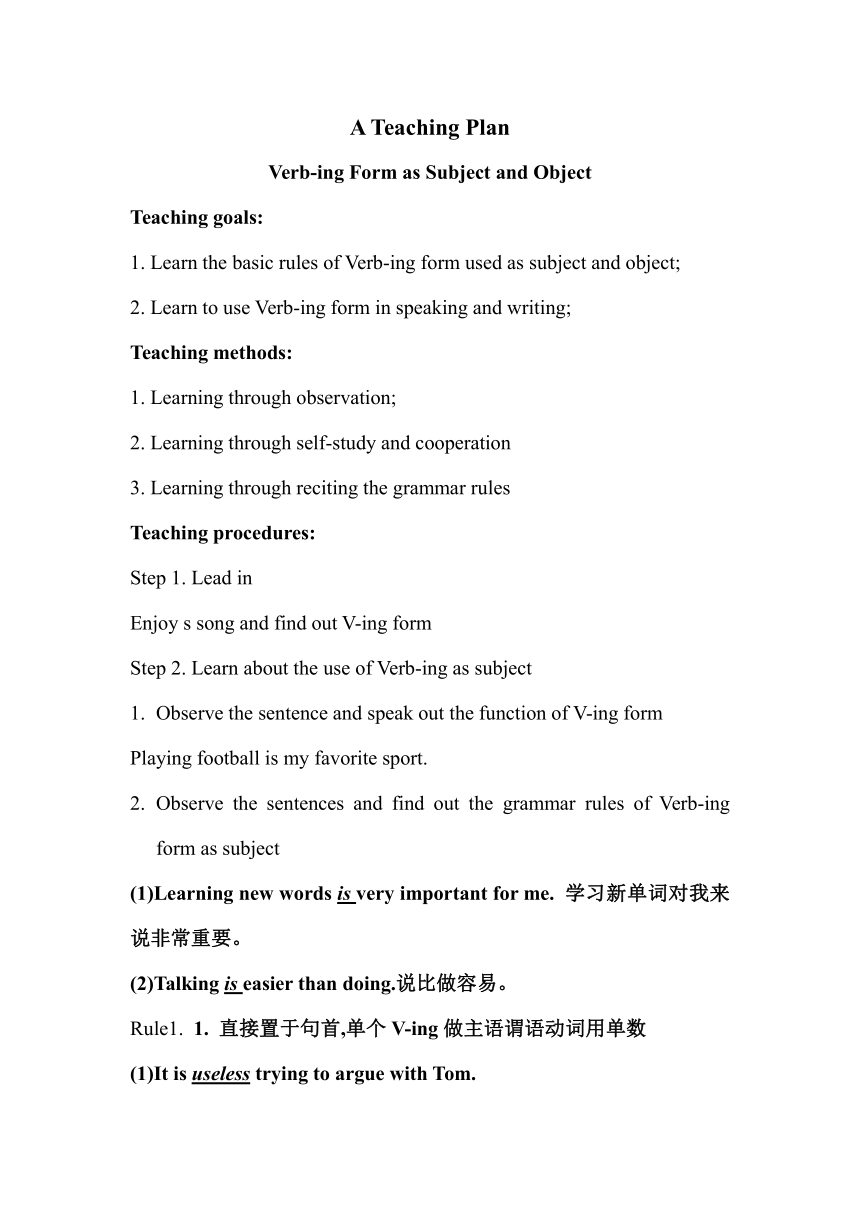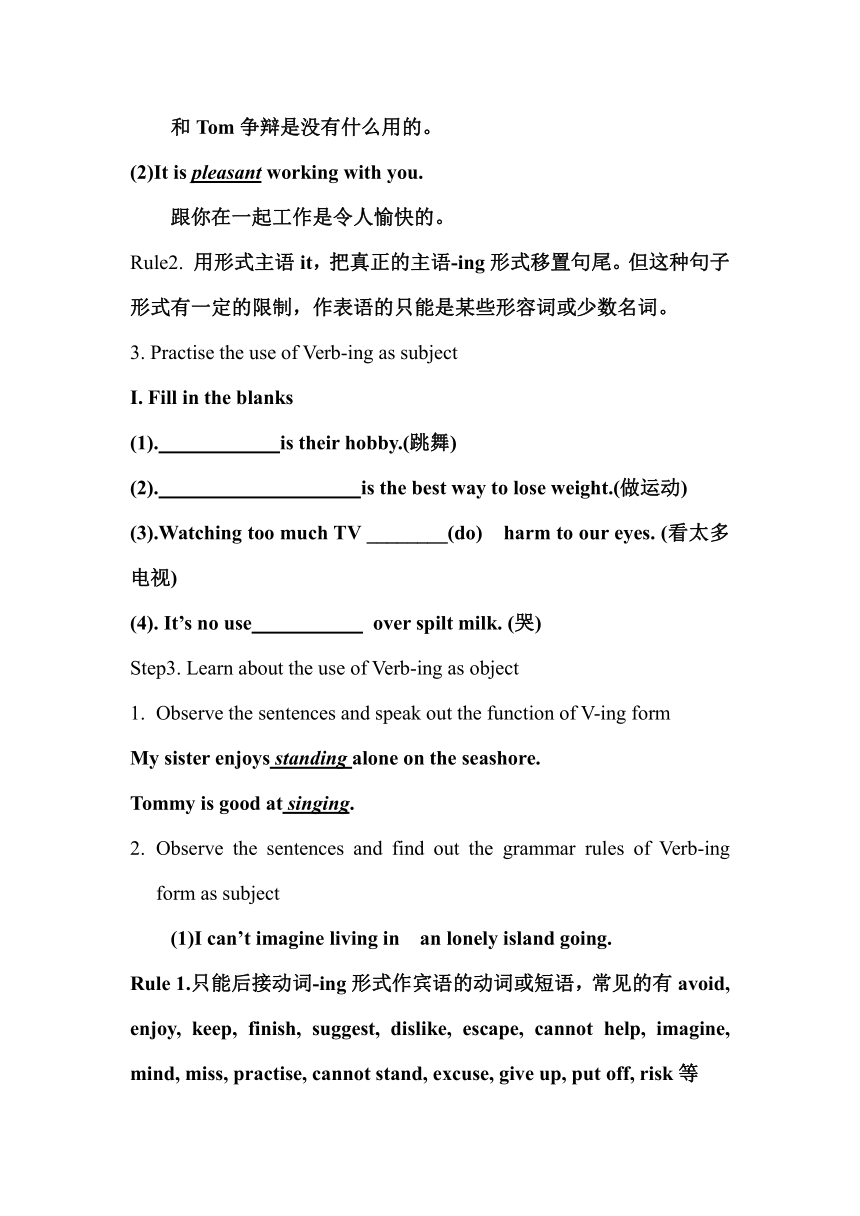高中英语人教版必修四Unit 2 Working the land Verb-ing Formas SubjectandObject教案
文档属性
| 名称 | 高中英语人教版必修四Unit 2 Working the land Verb-ing Formas SubjectandObject教案 |  | |
| 格式 | zip | ||
| 文件大小 | 17.4KB | ||
| 资源类型 | 教案 | ||
| 版本资源 | 人教版(新课程标准) | ||
| 科目 | 英语 | ||
| 更新时间 | 2022-01-24 15:58:43 | ||
图片预览


文档简介
A Teaching Plan
Verb-ing Form as Subject and Object
Teaching goals:
1. Learn the basic rules of Verb-ing form used as subject and object;
2. Learn to use Verb-ing form in speaking and writing;
Teaching methods:
1. Learning through observation;
2. Learning through self-study and cooperation
3. Learning through reciting the grammar rules
Teaching procedures:
Step 1. Lead in
Enjoy s song and find out V-ing form
Step 2. Learn about the use of Verb-ing as subject
Observe the sentence and speak out the function of V-ing form
Playing football is my favorite sport.
Observe the sentences and find out the grammar rules of Verb-ing form as subject
(1)Learning new words is very important for me. 学习新单词对我来说非常重要。
(2)Talking is easier than doing.说比做容易。
Rule1. 1. 直接置于句首,单个V-ing做主语谓语动词用单数
(1)It is useless trying to argue with Tom.
和Tom争辩是没有什么用的。
(2)It is pleasant working with you.
跟你在一起工作是令人愉快的。
Rule2. 用形式主语it,把真正的主语-ing形式移置句尾。但这种句子形式有一定的限制,作表语的只能是某些形容词或少数名词。
3. Practise the use of Verb-ing as subject
I. Fill in the blanks
(1). is their hobby.(跳舞)
(2). is the best way to lose weight.(做运动)
(3).Watching too much TV ________(do) harm to our eyes. (看太多电视)
(4). It’s no use over spilt milk. (哭)
Step3. Learn about the use of Verb-ing as object
Observe the sentences and speak out the function of V-ing form
My sister enjoys standing alone on the seashore.
Tommy is good at singing.
Observe the sentences and find out the grammar rules of Verb-ing form as subject
(1)I can’t imagine living in an lonely island going.
Rule 1.只能后接动词-ing形式作宾语的动词或短语,常见的有avoid, enjoy, keep, finish, suggest, dislike, escape, cannot help, imagine, mind, miss, practise, cannot stand, excuse, give up, put off, risk等
(1)I hope they continue to study hard when their teacher leaves.
(2)Mary and Tom continued working even though it was too late.
Rule2. . 既可接动词-ing又可接不定式作宾语的动词,常见的有:begin, start, continue, like, love, prefer, try, mean, forget, remember, hate, go on , stop等。
A. 在like, love, hate, prefer等动词之后用-ing或不定式意义上没有什么不同,只是侧重点有些不同,动词-ing形式表示泛指的动作,不定式表示具体的一次性动作。
B. 在begin/start, continue之后,用动词-ing和不定式,意义无甚区别,尤其是当主语是人的时候。
C. 在动词forget, remember, regret之后,用动词-ing与不定式意义不同。动词-ing表示动作先于谓语发生,不定式表示后于谓语动作。
D. 在try, mean之后,意义各不相同,如try to do (设法),try doing (试试),mean to do (打算,有意要做),mean doing (意思是,意味着)。
E. go on doing和go on to do:go on doing 继续做一直在做的事;go on to do 接着做另一件事。
F. stop doing与stop to do: stop doing 停止做; stop to do 停下正在干的事去干另一件事。
(1)He was looking forward to working with the new manager.
Rule3.作介词宾语;下列短语中的to都是介词,所以后面跟名词或-ing形式:devote to, pay attention to, get down to, lead to, look forward to, stick to,be used to, due to , thanks to 等
3. Practise the use of Verb-ing as object
I.Complete these sentences:
1. If you can keep ________(read) English newspapers, your English will be improved.
2. He has promised __________(come) to my birthday party.
3. I hate _________________(tell) lies!
4.I will never forget _________(go) to Beijing with him last summer.
I forgot _______(tell) her the news; so she knew nothing about it.
II.Translation
1.出国旅行是很激动人心的。
Travelling abroad is very exciting.
2. 我记得在哪里见过他。
I remember seeing him somewhere.
3. 我后悔没听你的劝告。
I regret not following your advice.
4. 帮助别人就是帮助你自己。
Helping others means helping yourself.
Step 4 Writing and speaking task
I. Watch a short video from a student and write a short introduction of yourself to her. The following sentence structures may help you a lot.
…is my job/dream every day.
I enjoy /love/am interested in…
I dream of /care about …
I hate /dislike …
… makes me happy/sad.
II. Share the writing with the whole class.
Step5. Conclusion.
Step6. Homework
1. Summarize the rules of v-ing form as the Subject and Object in your own way.
2. Finish the exercises of “Discovering useful structures” on Page 13.
3. Do some research on verbs following the questions:
*Which verbs should be followed by verb-ing form as object
*Which verbs should be followed by “to do ”
*Which verbs can be followed by both forms
Verb-ing Form as Subject and Object
Teaching goals:
1. Learn the basic rules of Verb-ing form used as subject and object;
2. Learn to use Verb-ing form in speaking and writing;
Teaching methods:
1. Learning through observation;
2. Learning through self-study and cooperation
3. Learning through reciting the grammar rules
Teaching procedures:
Step 1. Lead in
Enjoy s song and find out V-ing form
Step 2. Learn about the use of Verb-ing as subject
Observe the sentence and speak out the function of V-ing form
Playing football is my favorite sport.
Observe the sentences and find out the grammar rules of Verb-ing form as subject
(1)Learning new words is very important for me. 学习新单词对我来说非常重要。
(2)Talking is easier than doing.说比做容易。
Rule1. 1. 直接置于句首,单个V-ing做主语谓语动词用单数
(1)It is useless trying to argue with Tom.
和Tom争辩是没有什么用的。
(2)It is pleasant working with you.
跟你在一起工作是令人愉快的。
Rule2. 用形式主语it,把真正的主语-ing形式移置句尾。但这种句子形式有一定的限制,作表语的只能是某些形容词或少数名词。
3. Practise the use of Verb-ing as subject
I. Fill in the blanks
(1). is their hobby.(跳舞)
(2). is the best way to lose weight.(做运动)
(3).Watching too much TV ________(do) harm to our eyes. (看太多电视)
(4). It’s no use over spilt milk. (哭)
Step3. Learn about the use of Verb-ing as object
Observe the sentences and speak out the function of V-ing form
My sister enjoys standing alone on the seashore.
Tommy is good at singing.
Observe the sentences and find out the grammar rules of Verb-ing form as subject
(1)I can’t imagine living in an lonely island going.
Rule 1.只能后接动词-ing形式作宾语的动词或短语,常见的有avoid, enjoy, keep, finish, suggest, dislike, escape, cannot help, imagine, mind, miss, practise, cannot stand, excuse, give up, put off, risk等
(1)I hope they continue to study hard when their teacher leaves.
(2)Mary and Tom continued working even though it was too late.
Rule2. . 既可接动词-ing又可接不定式作宾语的动词,常见的有:begin, start, continue, like, love, prefer, try, mean, forget, remember, hate, go on , stop等。
A. 在like, love, hate, prefer等动词之后用-ing或不定式意义上没有什么不同,只是侧重点有些不同,动词-ing形式表示泛指的动作,不定式表示具体的一次性动作。
B. 在begin/start, continue之后,用动词-ing和不定式,意义无甚区别,尤其是当主语是人的时候。
C. 在动词forget, remember, regret之后,用动词-ing与不定式意义不同。动词-ing表示动作先于谓语发生,不定式表示后于谓语动作。
D. 在try, mean之后,意义各不相同,如try to do (设法),try doing (试试),mean to do (打算,有意要做),mean doing (意思是,意味着)。
E. go on doing和go on to do:go on doing 继续做一直在做的事;go on to do 接着做另一件事。
F. stop doing与stop to do: stop doing 停止做; stop to do 停下正在干的事去干另一件事。
(1)He was looking forward to working with the new manager.
Rule3.作介词宾语;下列短语中的to都是介词,所以后面跟名词或-ing形式:devote to, pay attention to, get down to, lead to, look forward to, stick to,be used to, due to , thanks to 等
3. Practise the use of Verb-ing as object
I.Complete these sentences:
1. If you can keep ________(read) English newspapers, your English will be improved.
2. He has promised __________(come) to my birthday party.
3. I hate _________________(tell) lies!
4.I will never forget _________(go) to Beijing with him last summer.
I forgot _______(tell) her the news; so she knew nothing about it.
II.Translation
1.出国旅行是很激动人心的。
Travelling abroad is very exciting.
2. 我记得在哪里见过他。
I remember seeing him somewhere.
3. 我后悔没听你的劝告。
I regret not following your advice.
4. 帮助别人就是帮助你自己。
Helping others means helping yourself.
Step 4 Writing and speaking task
I. Watch a short video from a student and write a short introduction of yourself to her. The following sentence structures may help you a lot.
…is my job/dream every day.
I enjoy /love/am interested in…
I dream of /care about …
I hate /dislike …
… makes me happy/sad.
II. Share the writing with the whole class.
Step5. Conclusion.
Step6. Homework
1. Summarize the rules of v-ing form as the Subject and Object in your own way.
2. Finish the exercises of “Discovering useful structures” on Page 13.
3. Do some research on verbs following the questions:
*Which verbs should be followed by verb-ing form as object
*Which verbs should be followed by “to do ”
*Which verbs can be followed by both forms
同课章节目录
